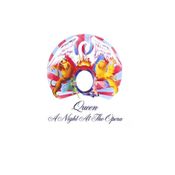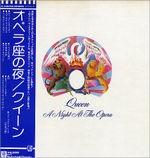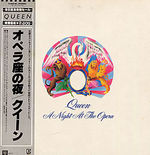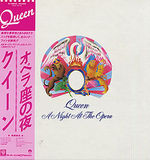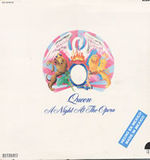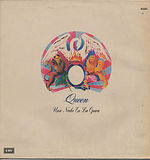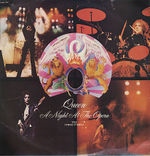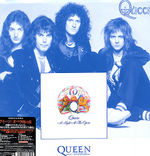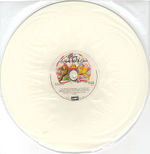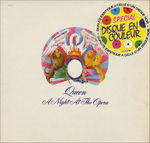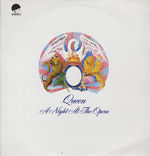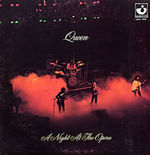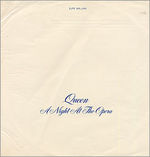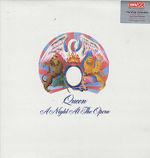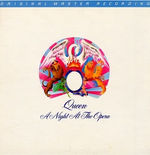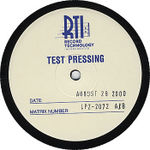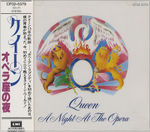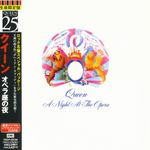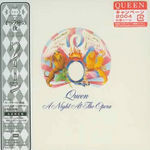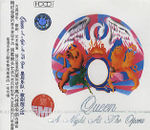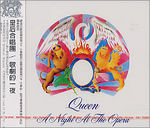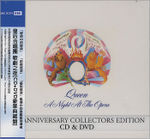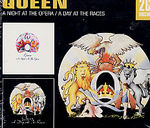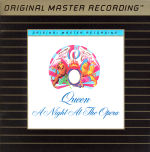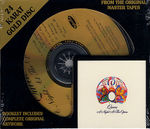From Queenpedia.com
Despite having two Top Ten albums and two Top Ten singles to their name, Queen found themselves in serious dire straits at the start of 1975. They had been touring and recording relentlessly for five years, and none of their hard work had started to pay off yet, which raised concerns for the band members. John had married his steady girlfriend, Veronica, in January, and had asked Queen's managers, Norman and Barry Sheffield, for an advance of £5,000 for the down payment of a house, which was outright rejected. Freddie, too, had started to lavish more decorations upon his flat, and was looking to purchase a piano for his own personal use, but money advancements were, again, denied. Health issues were also starting to plague the band. Though Brian had recovered nicely from his bout with hepatitis and gangrene from the spring of 1974, now Freddie's voice was starting to cause problems, and several dates on their US tour had to be canceled so that he could relax and save his throat. It was at first said that nodules had formed on his lymph nodes and that three months' rest was the only cure, but a second opinion revealed his throat was merely excessively swollen, and that only one or two weeks was necessary. Nevertheless, the band were understandably exhausted in the spring of 1975 after they finished up their lengthy tour (which included, for the first time ever, a tour of Japan). Things finally came to a head with the Sheffield brothers, and the band enlisted the services of Jim Beach, who initiated negotiations to sever all ties with their former management. The process dragged on for quite some time, but it would end up being a positive for the band in the long run – though it cost them £100,00 and that their former management would receive one percent of the royalties on Queen's next six albums. With this in mind, the band went into the recording studios (not Trident) to commence work on their fourth album, which Brian later called "our Sgt. Pepper." The band's desire to experiment had grown exponentially since their previous recording sessions, and it became another case of "making it or breaking it" – while they had passed the proverbial third album litmus test, they needed a massive hit single with which to cement their name firmly as a household item. Enter Bohemian Rhapsody. Much has been said about the song, so there will be no attempts here to try to decipher it, but simply said, Bohemian Rhapsody was one of the first true integrations of pomp and circumstance into the rock world. While many records had combined operatic sounds with rock (see The Man Who Sold The World by David Bowie, or Tommy by The Who), this was the first time that opera as an art form had merged with rock. The song took three weeks to record from start to finish, and a legend was started, and later confirmed by Brian and Roger, that so many overdubs had been added that the tape started to wear out; when the band held the tape to the light, they were alarmed to be able to see straight through it. At the end of the sessions, the band decided to take a chance and issue the six minute magnum opus as the first single from the album, but had elected not to edit the song down into a more consumable length for radio play. Even the ever-confident Freddie was starting to doubt himself, so he took the song over to his friend Kenny Everett, then a DJ on the BBC, and asked him his opinion of it. After hearing it for the first time, an astonished Kenny responded with, "Oh, forget about this. It could be a half an hour, it's still gonna be number one for centuries." Freddie then gave Kenny the tape, but made him promise not to play it on the air. Kenny promised at first, but, ever the cheeky one, he played it anyway – fourteen times over two days, which initially horrified the band, but caused a huge demand for the song, resulting in a rush-release single on October 31, 1975. Of course, we're getting ahead of ourselves here – there are many other songs on A Night At The Opera, all as grandiose and brilliant as Bohemian Rhapsody. The good ol' fashioned Queen snarl presided in Death On Two Legs (Dedicated to...... (a song written by Freddie about his former managers, though, to protect himself legally, they were never named), Roger's I'm In Love With My Car, and Brian's Sweet Lady. Freddie's Lazing On A Sunday Afternoon and Seaside Rendezvous were affectionate nods to the 1920s music hall and vaudeville genre, while Brian's Good Company was reminiscent of any number of glorious Kinks records released in the late 1960s. John's You're My Best Friend was a terrific pop single, while the balladic Love Of My Life, written by Freddie for Mary Austin, would endure and endear in nearly every country for the next thirty years. One other epic was constructed during the sessions – Brian's The Prophets Song, which recalled a particular dream he had in which Mother Earth hatches revenge against her inhabitants. Clocking in at over eight minutes, the song was reportedly considered for single release at one point, though the lengthy vocal interlude would likely have been cut; another of Brian's songs, the space folk (!!!) '39, would turn up as the B-side of You're My Best Friend in May 1976, and was one of two songs on the album to feature Brian on lead vocals. The grand finale was a suitably over-the-top arrangement of Britain's national anthem, which had been sung by audiences during homeland concerts while they were waiting for the band to enter the stage. The song had actually been recorded during sessions for Sheer Heart Attack at Rockfield Studios, and was used from October 1974 until August 1986, and again during the Queen + Paul Rodgers tour, to herald the end of Queen's shows. The album was released in November 1975 – a mere fortnight after the Bohemian Rhapsody single shot into the UK charts – and reached #1 in the UK, and #4 in the US, the first time any of Queen's albums had broken through the Top Ten. Bohemian Rhapsody reached #1 in the UK and #9 in the US, while the follow-up single, John's You're My Best Friend, peaked at #7 in the UK and #16 in the US. The album has been privvy to several re-releases along the way, including the 1991 Hollywood Records reissue that saw special remixes of You're My Best Friend and I'm In Love With My Car tacked on as bonus tracks (it would seem that all the material recorded for the album was released, so, until anyone else says otherwise, any additional titles that may crop up on less reliable encyclopedia sites are just boring jokes propagated by equally boring people). The album was also mixed into 5.1 surround sound and released on DVD-A in 2000 and 2002, with the two-disc 30th anniversary edition featuring both a remastered CD and the DVD-A, though worth picking up would be the 2005 documentary The Making Of A Night At The Opera, which features Roger and Brian, along with assorted individuals (producers, engineers, peers, record executives, and rock critics) discussing the album at length. The band knew rather early on that they had something special on their hands, and invited the press for a special hearing of the album only days before they were due to go on tour again. The album was still being mixed hours before the playback, and further tweaks and edits were made afterward, but the general consensus was that Queen had recorded a killer album, and that it blew their previous three albums out of the water. More than thirty years on, it's hard to disagree. Tracklists
Credits
Charts
Singles
Reviews
Sleeves |
|||||||||||||||||||||||||||||||||||||||||||||||||||||||||||||||||||||||||||||||||||||||||||||||||||||||||||||||||||||||||||||||||||
